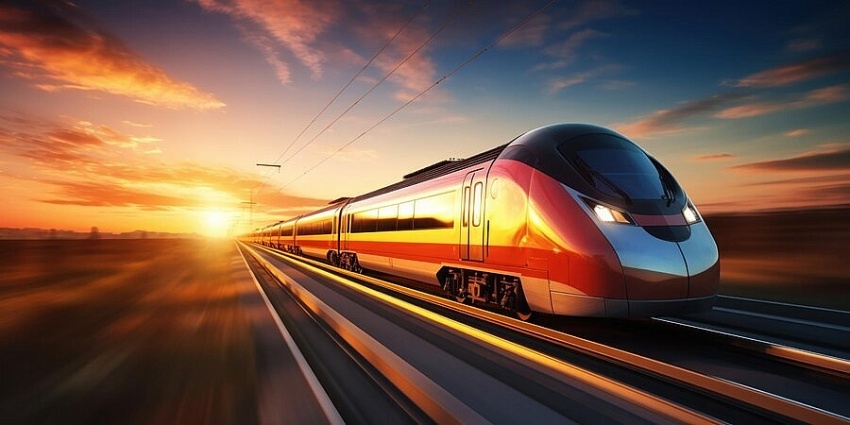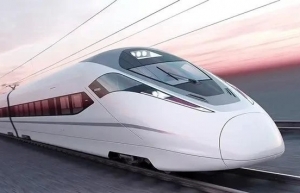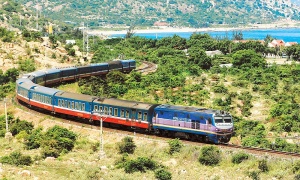High-speed rail could yet become reality
 |
| High-speed rail could yet become reality (illustration photo/ Source: freepik.com) |
At a workshop held last week by the Vietnam Institute for Economic and Policy Research in Hanoi, Pham Chi Lan, an economist and former vice president of the Vietnam Chamber of Commerce and Industry, said she supported the idea, and emphasised that it would be vital for Vietnam’s future, though she acknowledged the challenges in its execution.
“Although significant investment has been made in other forms of transport, high-speed rail will remain a critical piece of infrastructure with numerous long-term benefits,” Lan said. “But the biggest challenges are how and when we implement it and where the necessary resources will come from. It’s crucial that we’ve studied the project carefully and considered all alternative approaches.”
Initial proposals for a high-speed rail line outline a plan to start at Ngoc Hoi station in Hanoi and end at Thu Thiem station in Ho Chi Minh City, with a total length of almost 1,550km. The railway would pass through 20 provinces and cities.
The Politburo has approved the general plan for a 350km/h railway, to be developed using public funds. It would be designed to meet both civilian and military needs, with the potential for transporting goods if required.
The proposal enjoys broad support, but experts are divided between two options: building a railway capable of 350km/h, which would be for passenger use only, or a more moderate-speed option, around 250km/h, which would cater to both passengers and freight.
“Transporting goods efficiently and at a lower cost will significantly enhance economic development and raise the quality of life for many. As the economy grows and incomes rise, people will be better able to afford to use high-speed rail. Without this economic progress, we may not achieve the expected revenue from passenger services,” Lan said.
Another point raised by Lan was the growing role of private Vietnamese enterprises in large-scale projects. “In the past, major projects were usually handled by state-owned or foreign enterprises. Today, however, Vietnam’s private sector has grown remarkably, and many large firms now can contribute meaningfully to important projects like this,” she said.
The economist also warned of the natural challenges presented by Vietnam’s geography, particularly in the central region, which is prone to extreme weather.
“We must thoroughly assess the risk of landslides, floods, and other natural disasters. If these factors aren’t properly accounted for, the project might not deliver the desired outcomes,” she said.
Last week, the Ministry of Planning and Investment (MPI) issued a notice on the conclusions of the State Appraisal Council on the pre-feasibility study of a north-south high-speed rail line. Minister Nguyen Chi Dung, who chairs the council, emphasised the special nature of the project, both in terms of its scale and its long-term technological impact.
“This is a critical piece of transport infrastructure that will influence Vietnam for hundreds of years. The appraisal process must be handled with care, insight, and expertise to offer sound recommendations for policymakers,” Minister Dung stated. “We need to carefully consider how this infrastructure will connect with other transport corridors, seaports, airports, and neighbouring countries such as China, Laos, and Cambodia,” he said.
The railway must also be designed to minimise construction costs by following a straight route, avoiding urban areas, and opening up new development spaces. This updated plan has already been integrated into the provincial planning of the regions it will pass through.
“The route has been thoroughly studied to ensure it meets the economic and technical requirements for the designed speed while offering passengers a smooth travel experience,” said Deputy Minister of Transport Nguyen Danh Huy.
Huy also highlighted the importance of station design, noting that stations must be large enough to accommodate future growth and offer a range of modern services. “The long-term vision is to maximise land resources and create new spaces for development around these stations,” he said.
Minister Dung warned against inflating the proposal’s financial picture and called for an honest assessment of construction and operational costs. “This is a proposal with tremendous socioeconomic and national security value, but we need to ensure its financial feasibility. Specific mechanisms and impact assessments must be made to ensure its legal validity and compliance,” he said.
The MPI notice called for the Ministry of Transport to review and refine its total investment estimates, ensuring all calculations comply with legal regulations. The appraisal council has requested additional information on the proposal’s capital mobilisation plan to confirm that it is financially viable and legally sound.
Because it is expected to take more than 10 years to see any high-speed railway complete, Minister Dung acknowledged that the total investment could fluctuate due to external factors such as natural disasters, policy changes, or inflation. He reassured stakeholders that the feasibility study would be regularly updated to ensure the project’s accuracy and suitability to Vietnam’s current conditions.
Economist Lan also underscored the importance of broad consultation, involving not only experts but also the public.
“With an estimated investment of $70 billion, it’s not only about making sure the project is efficient, but also about weighing the opportunity costs. We must carefully assess whether allocating such resources to this proposal might limit investment in other areas, such as digital and green transformation, or industrial modernisation, which could yield more immediate benefits,” Lan said.
| The proposal features a new double-track railway designed for speeds of 350km/h, and will include 23 passenger stations and five freight stations. The railway is expected to require approximately 10,800 hectares of land, with a total investment of around $70 billion. Public investment will be sourced from the central budget over medium-term periods, alongside capital contributions from localities and mobilised foreign capital through low-cost loans. Businesses will be invited to invest in commercial services at the stations. A feasibility study is scheduled for 2025-2026, and construction could begin as early as 2027. The 10th Central Conference has approved the investment policy, and the proposal will be submitted to the National Assembly at its upcoming session. |
 | Positive signs for implementing North-South high-speed railway project After several rounds of feedback from ministries, sectors, and experts, the Ministry of Transport is finalising the proposal for the construction of the North-South high-speed railway, as the funding plan for the project has shown positive signs, Deputy Minister of Transport Nguyen Danh Huy has said. |
 | PM orders stronger efforts to speed up site clearance for key transport projects Prime Minister Pham Minh Chinh has signed to issue an official dispatch asking for drastic efforts, the highest sense of responsibility and the engagement of the entire political system to speed up site clearance for national key transport projects. |
 | Private investment in railway industry yet to shine Vietnam’s railway industry is waiting for legal improvements to increase its attraction. Tran Thien Canh, director of the Vietnam Railway Authority, talked to VIR’s Tung Anh about the prospects for the sector in this country. |
What the stars mean:
★ Poor ★ ★ Promising ★★★ Good ★★★★ Very good ★★★★★ Exceptional
Related Contents
Latest News
More News
- Unlocking capital flows for strategic and suitable projects (January 18, 2026 | 09:00)
- ACV begins cargo terminal construction at Danang Airport (January 17, 2026 | 15:57)
- Viettel starts construction of semiconductor chip production plant (January 16, 2026 | 21:30)
- Bel expands Vietnam production with $19.7 million investment (January 16, 2026 | 16:07)
- ASML signals long-term commitment to Vietnam (January 16, 2026 | 12:00)
- Ho Chi Minh City starts construction of four key infrastructure projects (January 15, 2026 | 17:22)
- PIDG invests with AquaOne to expand Xuan Mai’s treated water supply to Hanoi (January 15, 2026 | 11:16)
- Vietnam ranks 38th in global AI adoption (January 14, 2026 | 16:01)
- European business confidence reaches highest in seven years (January 13, 2026 | 10:17)
- Vietnam’s regional influence draws renewed global attention (January 12, 2026 | 13:59)

 Tag:
Tag:



















 Mobile Version
Mobile Version